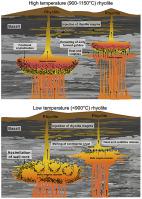Geoscience Frontiers ( IF 8.9 ) Pub Date : 2020-08-05 , DOI: 10.1016/j.gsf.2020.06.011 Mahesh Halder , Debajyoti Paul , Sarajit Sensarma

|
We present a detailed review of the petrological and geochemical aspects of rhyolite and associated silicic volcanic rocks (up to 20 vol% of all rocks) reported to date from twelve well known Phanerozoic continental mafic Large Igneous Provinces (LIPs). These typically spread over ≤104 km2 (rarely 105 km2 for Paraná-Etendeka) area and comprise ≤104 km3 of extrusive silicic rocks, erupted either during or after the main basaltic eruption within <5 Myr, with some eruption(s) continuing for ≤30 Myr. These rhyolites and associated silicic volcanic rocks (60−81 wt.% of SiO2) are mostly metaluminous to peraluminous and are formed via (i) fractional crystallization of parental mafic magma with negligible crustal contamination, and (ii) melting of continental crust or assimilation and fractional crystallization (AFC) of mafic magma with significant crustal contribution. Rhyolites formed by extensive fractional crystallization are characterized by the presence of clinopyroxene phenocrysts, exhibit steep negative slopes in bivariate major oxides plots and weak to no Nb-Ta anomaly; these typically have temperature >900 °C. Rhyolites formed by significant crustal contribution are characterized by strong negative Nb-Ta anomalies, absence of clinopyroxene phenocrysts, and are likely to have a magma temperature <900 °C. Geochemical signatures suggest rhyolite melt generation in the plagioclase stability field with a minor fraction originating from lower crustal depths. A large part of the compositional variability in rhyolites, particularly the Sr-Nd-Pb-O isotope ratios, suggests a significant role of continental crust (upper crustal melting or AFC) in the evolution of these silicic rocks in the continental mafic LIPs.
中文翻译:

火成岩大陆大省的流纹岩:岩石学,地球化学和岩石成因
我们目前对流纹岩和相关的硅质火山岩(占所有岩石的20%)的岩石学和地球化学方面进行了详细的回顾,该报道来自十二个著名的生代大陆镁铁质大火成岩省(LIPs)。这些典型地分布在≤10 4 公里2(很少10 5 公里2为巴拉-Etendeka)区域和包括≤10 4 公里3喷出硅酸岩期间或<5秘耳内的主玄武喷发后,爆发要么,爆发持续≤30 Myr。这些流纹岩和相关的硅质火山岩(SiO 2的60-81 wt。%)多数为金属质至高铝质,是通过(i)母体基性岩浆的分步结晶和地壳污染可忽略不计,以及(ii)大陆壳熔融或同化作用和镁质岩浆的分步结晶(AFC)组成,具有明显的地壳作用。由大量分步结晶形成的流纹岩的特征是存在斜辉石苯晶,在双变量主要氧化物图中显示出陡峭的负斜率,并且几乎没有Nb-Ta异常。这些通常的温度> 900°C。由显着的地壳作用形成的流纹岩的特征是强烈的负Nb-Ta异常,不存在斜辉石苯晶,并且岩浆温度可能低于900°C。地球化学特征表明,斜长石稳定性场中流纹岩熔体生成,其中一小部分来自地壳较低深度。流纹岩的很大一部分组成变异性,特别是Sr-Nd-Pb-O同位素比,表明陆相地壳(上地壳熔融或AFC)在陆相镁铁质LIP中这些硅质岩的演化中起着重要作用。



























 京公网安备 11010802027423号
京公网安备 11010802027423号